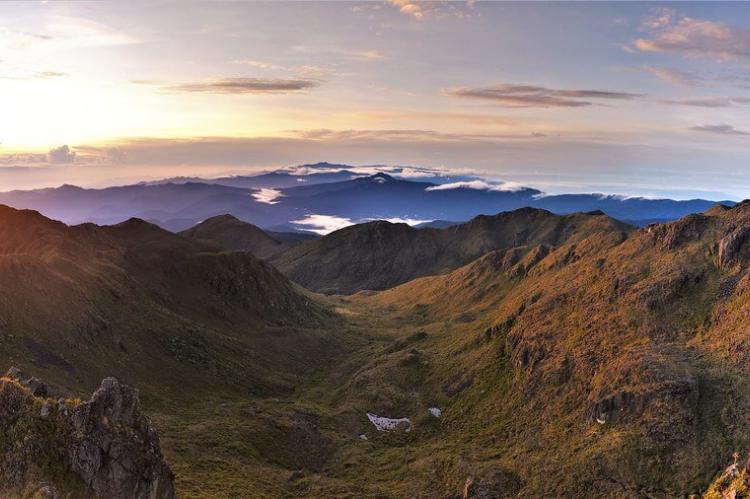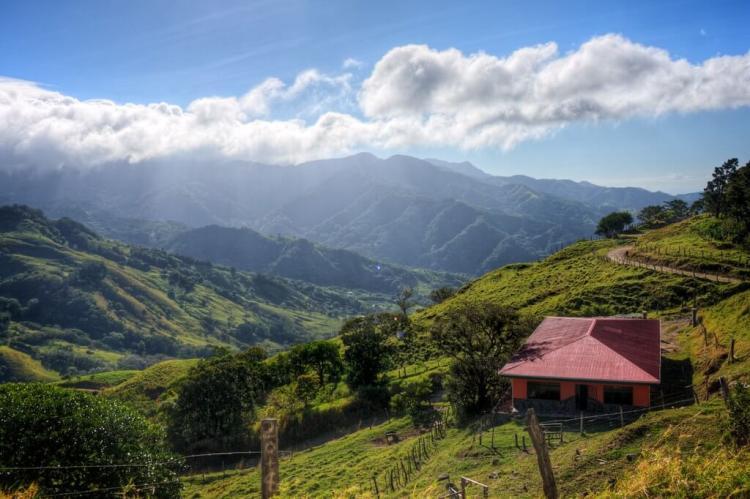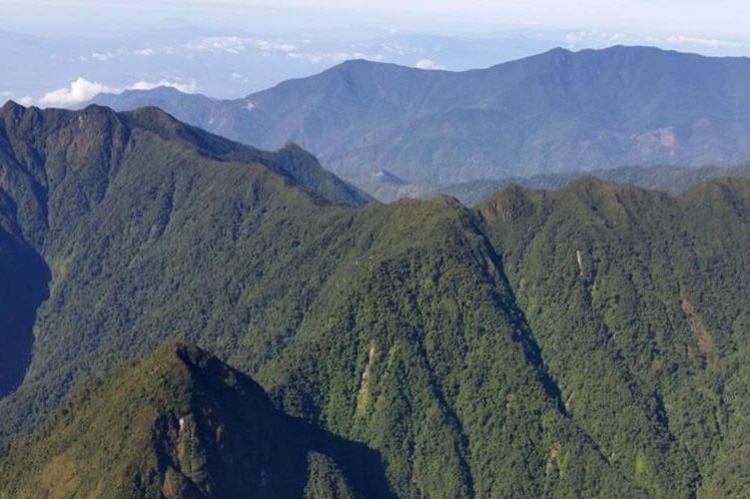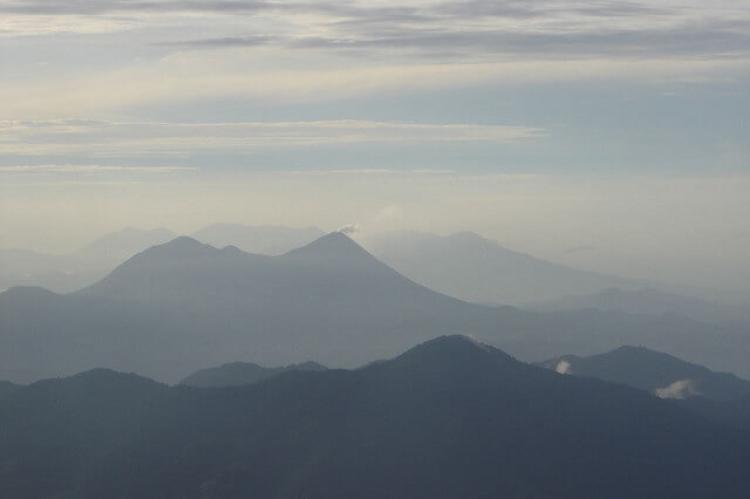Mountain Ranges of Central America
Central America is a region blessed with a remarkable diversity of mountain ranges that span its seven countries. These mountainous landscapes contribute to the region's captivating scenery, rich ecological heritage, and cultural significance.
Mountain Ranges of Central America
Central America is a region blessed with a remarkable diversity of mountain ranges that span its seven countries: Belize, Costa Rica, El Salvador, Guatemala, Honduras, Nicaragua, and Panama. These mountainous landscapes contribute to the region's captivating scenery, rich ecological heritage, and cultural significance. The mountains and highland areas provide essential habitats for various plant and animal species and offer opportunities for eco-tourism and outdoor activities.
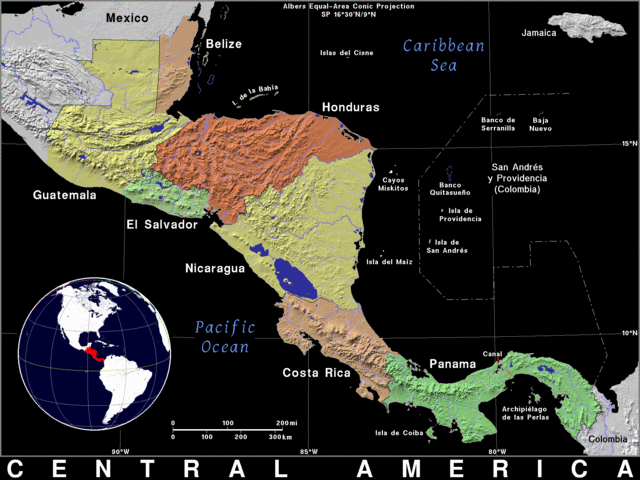
Relief map of Central America.
Belize
Belize, while not known for its extensive mountains, does have a notably elevated region called the Maya Mountains. This mountainous area is located in the southern part of the country and is characterized by rugged terrain, dense forests, and various limestone formations.
- Maya Mountains: The Maya Mountains range from low to medium-elevation mountains in southern Belize. While they might not match the grandeur of some other mountain ranges, the Maya Mountains hold ecological and cultural significance.
Guatemala
Guatemala is home to several significant mountain ranges, thanks to its complex geological history and diverse topography.
-
Sierra Madre de Chiapas: Located in the western highlands, this mountain range extends from the southern part of Mexico into Guatemala and El Salvador. It is part of the more extensive Sierra Madre mountain system, which runs along the western coast of Mexico and Central America. It is the highest mountain range in Central America, with its highest peak, Tajumulco, reaching an elevation of 4,220 m (13,845 ft). Volcanic peaks, cloud forests, and highland páramo ecosystems characterize it.
-
Sierra de los Cuchumatanes: Located in the western highlands of Guatemala, this range is known for its high plateaus and deep valleys. It is known for its rugged landscapes, high plateaus, and deep valleys, making it one of Central America's most stunning and less-explored mountain regions. It includes the Cuchumatanes Massif, Central America's highest non-volcanic mountain range.
-
Sierra de las Minas: The Sierra de las Minas is a mountain range in eastern Guatemala. It is 15 - 30 km (10 - 20 mi) wide and bordered by the valleys of the Polochic River in the north and the Motagua River in the south. Its western border is marked by the Salamá River valley, which separates it from the Chuacús mountain range.
El Salvador
Although a small country, El Salvador has several significant mountain ranges contributing to its varied landscape and ecosystems. While smaller in scale than more prominent countries, these mountain ranges are essential in shaping El Salvador's geography, climate, and culture.
-
Cordillera de Apaneca-Ilamatepec: This range is situated in the western part of El Salvador, close to the border with Guatemala. It is part of the larger Central America Volcanic Arc and runs parallel to the Pacific coast. It features rolling hills, deep valleys, and cloud forests. The range is known for its picturesque landscapes, including lush coffee plantations and volcanic hills. The Ilamatepec Volcano, also known as Santa Ana Volcano, is the highest point in El Salvador.
-
Sierra de Lempa: Running through central and eastern El Salvador, rolling hills, fertile valleys, and agricultural landscapes characterize the Sierra de Lempa. It is an important region for coffee cultivation and other crops. The range is near the Lempa River, a significant water source for the country.
-
Sierra de San Vicente: Located in the central part of El Salvador, this range is home to the San Vicente Volcano. The volcano is still a notable landscape feature while not as high as some other peaks. The region's volcanic soils contribute to agriculture, and there are also geothermal resources.
-
Cordillera de Tecapa-Chinameca: Situated in the eastern part of the country close to the border with Honduras. It runs north-south and is between the San Miguel and La Unión departments. The range is volcanic in origin and includes several volcanic peaks, some of which are active. Two prominent volcanoes are Volcán Tecapa and Volcán Chinameca.
-
Cordillera de Los Planes: Cordillera de Los Planes is located in the center of the country, and it is home to the second-highest peak in El Salvador, Cerro Guazapa, which is 2,381 m (7,811 ft) tall.
-
In addition to these mountain ranges, there are a couple of smaller mountain ranges in El Salvador, including the Cordillera de Jiboa and the Cordillera de Guazapa.
Honduras
Honduras has varied topography, including several significant mountain ranges contributing to its landscapes, ecosystems, and cultural heritage.
-
Cordillera de Merendón: The Cordillera de Merendón is a mountain range located in the north of Honduras. It is part of the Central America Volcanic Arc and runs east to west for about 100 km (623 mi). The highest peak in the range is Cerro El Pital, which reaches 2,849 m (9,347 ft) in elevation. It is known for its lush cloud forests, diverse flora and fauna, and rugged terrain.
-
Cordillera de Agalta: Cordillera de Agalta is located in the northeast of Honduras, and it is home to the highest peak in the country, Cerro Las Minas, which is 2,870 m (9,416 ft) tall.
-
Cordillera de Nombre de Dios: This range is located in the southwest of Honduras and is home to the Maya archaeological site of Copán.
-
In addition to these three main mountain ranges, there are a few smaller mountain ranges in Honduras, including the Cordillera de Celaque, the Cordillera de Opalaca, and the Cordillera de Lenca.
Nicaragua
A diverse topography characterizes Nicaragua, home to several significant mountain ranges contributing to its landscapes and ecosystems. These mountain ranges in Nicaragua contribute to the country's diverse geography, ecosystems, and cultural heritage.
-
Cordillera Isabelia: This range is the northern portion of the central mountain range in Nicaragua, which runs from northwest to southeast through the country's center. Isabelia reaches 2,107 m (6,912 ft) at Pico Mogoton, on the border with Honduras. Many of the mountains are forested with deep valleys.
-
Cordillera de los Maribios: This range is located in western Nicaragua, extending in a northwest-to-southeast direction, and is home to several active and dormant volcanoes, including Momotombo and Cerro Negro.
-
Cordillera de Dipilto y Jalapa: The Cordillera de Dipilto y Jalapa runs in a north-south direction, starting near Jalapa in northern Nicaragua and extending towards the Honduran border. The range is an important water system for both countries. This range includes the highest peak in Nicaragua, Mogotón, at 2,085 m (6,841 ft).
-
Cordillera Dariense: The Cordillera Dariense is located in the north-central area of Nicaragua. It is home to the second-highest peak in the country, Cosigüina, which is 2,106 m (6,906 ft) tall.
-
In addition to these mountain ranges, there are a couple of smaller mountain ranges in Nicaragua, including the Sierra de Amerrisque and the Sierra de Managua.
Costa Rica
Costa Rica is known for its impressive and diverse mountain ranges that contribute to its stunning landscapes, rich biodiversity, and unique ecosystems. These mountain ranges in Costa Rica play a vital role in shaping the country's natural beauty, ecosystems, and cultural heritage.
-
Cordillera de Guanacaste: Located in the northwestern part of Costa Rica, the Cordillera de Guanacaste is part of the larger volcanic chain that extends through Central America. This mountain range includes active and dormant volcanoes, such as Rincón de la Vieja, Miravalles, and Tenorio. The region is known for its volcanic landscapes, geothermal activity, and diverse flora and fauna.
-
Cordillera de Tilarán: The Cordillera de Tilarán lies between the Guanacaste and Central mountain ranges and runs from northwest to southeast. It is also part of the volcanic chain and features the famous Arenal Volcano and lush cloud forests. Lake Arenal, Costa Rica's most prominent, is a popular destination for water sports and nature enthusiasts.
-
Cordillera Central: Also known as the "Volcanic Cordillera," this mountain range stretches from the north through the central part of Costa Rica and is home to several active volcanoes, including Poás, Irazú, and Turrialba. This range includes the highest peak in Costa Rica, Cerro Chirripo, which rises to approximately 3,821 m (12,536 ft). Its cloud forests, oak forests, and abundant wildlife characterize the range.
-
Cordillera de Talamanca: One of the most extensive ranges in Central America, the Cordillera de Talamanca runs along the southern part of Costa Rica and extends into Panama. It includes the highest peak in Costa Rica and Central America, Cerro Chirripó, reaching an elevation of 3,819 m (12,530 ft). The region is known for its high-altitude páramo ecosystems, tropical cloud forests, and unique biodiversity.
Panama
Panama, located at the crossroads of Central America, features several significant mountain ranges that contribute to its diverse landscapes, ecosystems, and cultural heritage.
-
Cordillera de Talamanca: The Cordillera de Talamanca extends from Costa Rica into western Panama and is one of the most significant mountain ranges in the country. It features rugged terrain, cloud forests, and high-altitude páramo ecosystems. The highest peak in Panama is Volcán Baiss, at approximately 3,474 m (11,398 ft). The Talamanca range is renowned for its biodiversity and is part of the Mesoamerican Biological Corridor.
-
Serranía de Tabasará: The Serranía de Tabasará is located in southern Panama, running parallel to the Cordillera de Talamanca. This mountain range is known for its forested slopes and provides habitat for various wildlife species. The region plays a vital role in water catchment, supplying fresh water to rivers and streams that flow to the Pacific and Atlantic coasts.
-
Cordillera Central: Cordillera Central is located in the central part of Panama, parallel to the Panama Canal. This mountain range is less prominent than the Cordillera de Talamanca but is still significant for its ecological importance. Cloud forests, rivers, and lush vegetation characterize the region.
-
Serranía del Darién: The Serranía del Darién is situated in eastern Panama, near the border with Colombia. This mountain range is part of the more significant Darién Gap, an area of dense rainforest and swamps that is challenging to traverse. The region is home to unique ecosystems and indigenous communities that have maintained their traditional way of life for centuries.
-
In addition to these mountain ranges, there are also several smaller mountain ranges in Panama, including the Cordillera de San Blas, the Cordillera de Coclé, and the Cordillera de Chiriquí.
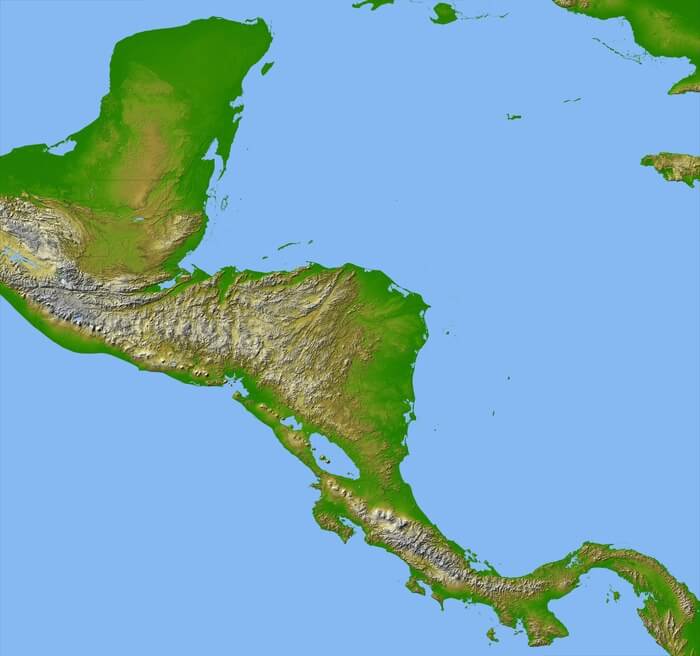
Relief map of Central America.
